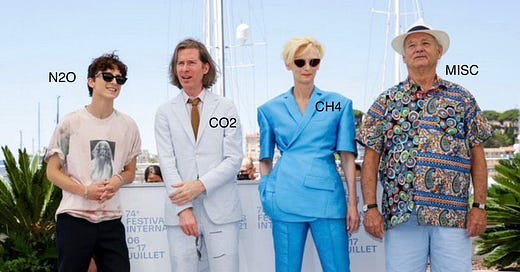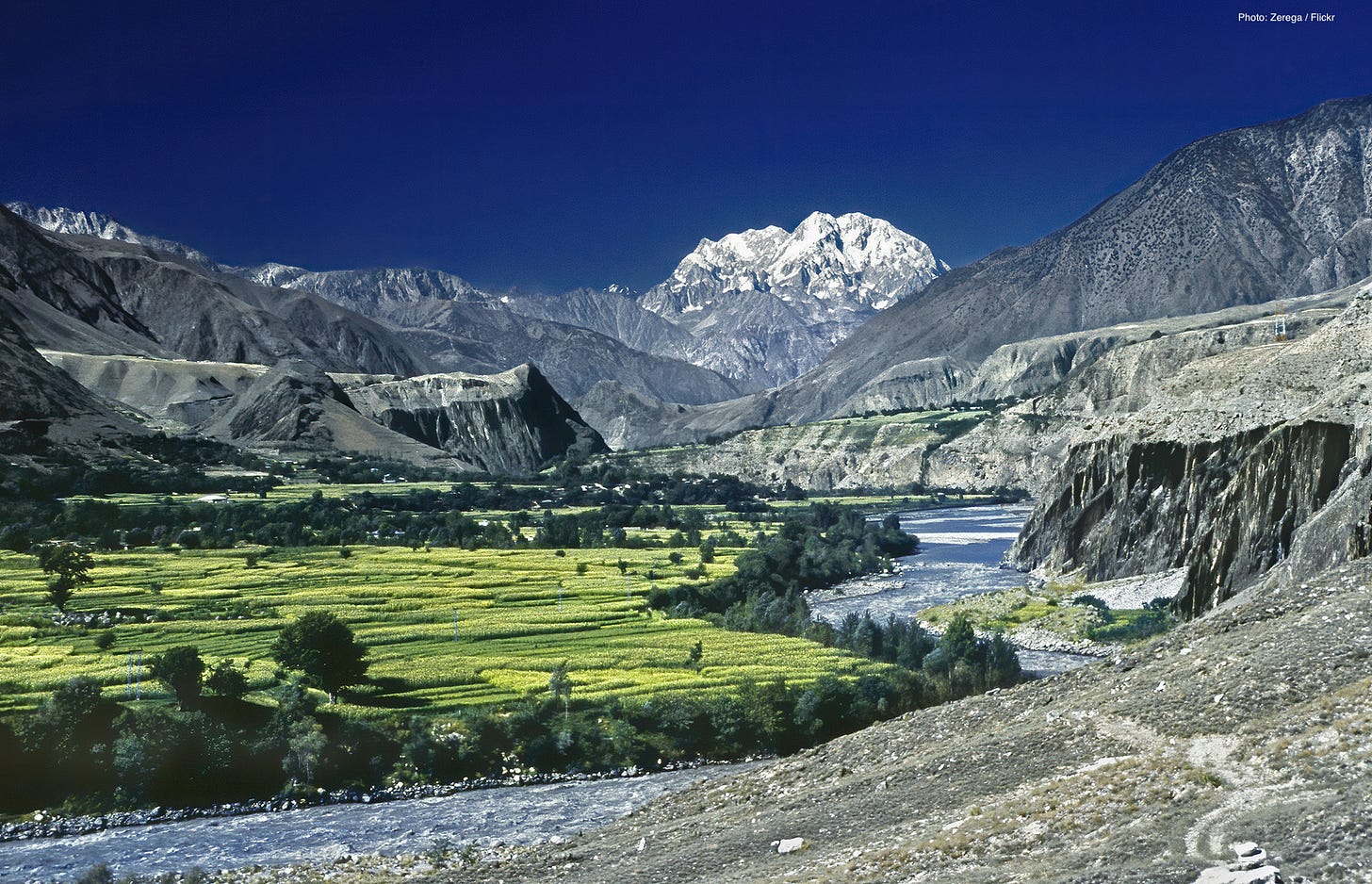Do you care about climate change, but not know how to respond when:
Your uncle says we still need fossil fuels for “when the sun’s not shining and the wind’s not blowing”? 🧐
Jetstar asks if you want to pay $3.24 to offset your flight to Bali? ✈️
A billionaire tells you hydrogen is going to save the planet?💸🍾
This newsletter might be for you. Welcome to Carbon Dispatch.
Each edition, I’ll break down a key climate concept, dive into a topical issue, and finish with something fun.
Note: I’ve subscribed you to Carbon Dispatch because you’ve expressed interest in the idea, or because I’ve unilaterally decided you’d be interested. If I’m wrong, feel free to hit unsubscribe at the bottom of this email.
This inaugural dispatch covers greenhouse gas emissions, and I think you’ll find some of it surprising. But in the coming weeks, we’ll cover topics like:
Net zero by 2050 — what does it really mean?
Renewables — how reliable are they?
Can we really capture carbon?
Why is everyone suddenly talking about hydrogen?
The goal is to keep it simple — so you can go forth and be informed as you discuss and debate.
GREENHOUSE GASBAGGING - let’s talk emissions 🏭
Most people understand that burning fossil fuels to make electricity produces carbon dioxide, which hangs out in the atmosphere, trapping heat and slowly cooking the planet. And that really is where most of our emissions come from. But it’s not the whole story…
What even are emissions
Carbon dioxide (CO2), methane (CH4), and nitrous oxide (N2O) are the main greenhouse gases (GHG).
They are each uniquely perilous — e.g. carbon dioxide doesn’t trap as much heat as methane, but stays in the atmosphere longer. Nitrous oxide traps far more heat than both methane and carbon dioxide but we emit it in much smaller amounts.
Carbon dioxide accounts for about 75% of global emissions, followed by methane at 17%, and nitrous oxide at 6%, with a group of smaller gases covering the remainder.
Now we know what greenhouse gases are, let’s look at the breakdown of global emissions, by sector.
Source: for this chart and the below, I relied on this neat consolidation by Lamb, Weidmann et al. Data is from 2018. The figures include all greenhouse gases, converted into CO2 equivalent.
Energy systems⚡️~34% of global emissions
The vast majority of energy system emissions are carbon dioxide, generated as we burn fossil fuels to make electricity and heat (much of it destined for the industrial and building sectors).
However, emissions from burning the fuels aren’t the only problem. Extracting gas or coal from the ground results in emissions “leakage”. We call these leaky emissions fugitives (and they’re largely methane, which means they’re especially effective at trapping heat in the atmosphere).
Fun fact: Energy system emissions are actually a good(ish) news story when it comes to climate change, because we’ve made real progress finding alternatives to fossil fuels.
The price of renewables has dropped significantly — solar panels have seen a 90% cost reduction in the last decade or so — and their deployment has skyrocketed.
For this reason, energy system emissions are often seen as the ‘low hanging fruit’ of climate action. But the work is far from done — we need to dramatically accelerate global uptake of renewables this decade, which means reconfiguring the way our electricity grids operate. More on that soon.
Transport 🚗 ~14%
These are mostly from your car. Not yours, personally. But everyone’s cars. Then road freight, followed by aviation, shipping and finally rail.
Unfun fact: in gas-guzzling USA, transport comprises a staggering 30% of emissions.
Fun fact: Rapid electric vehicle adoption will be key to bringing down global emissions, but we need to make sure we’re also decarbonising our electricity grids so we’re not substituting one dirty fuel (petrol) for another (electricity from coal). Having said that, a car charged by a coal-powered grid is still significantly better for the planet than a car fuelled by petrol.
Industry ⚙️ ~25%
The majority of industry emissions come from factories (think aluminium smelters, steelmakers, cement producers) burning their own fossil fuels to generate power.
But some industries generate ‘process’ emissions, created via chemical transformation of materials. E.g., when you make cement, calcium carbonate (CaCO3) is converted to lime (CaO) … high school chemistry … CO2 is a byproduct.
It’s important to remember factories are also sourcing a lot of power from the grid, which means they’re indirectly responsible for a large chunk of the ‘energy systems’ emissions above.
Unfun fact: Steelmaking alone accounts for around 7% of global emissions… here’s an interesting New Yorker article on the subject, if you really want to nerd out.
Buildings 🏙 ~6%
You probably never thought much about building emissions, most of which come from things like gas and coal boilers, or kerosene cooking (not super common here, but more so in the developing world).
However, if you include the energy buildings consume from the electricity grid (that is, you reallocate emissions from the ‘energy systems’ category to ‘buildings’) the 6% jumps to 17%.
Agriculture, Forestry and other Land Use Change … AFOLU! 🌾 ~21%
Enteric emissions (polite way of saying animal burps and farts) make up a quarter of all agriculture and land related emissions, and about 5% of total global emissions. 🐄💨
That doesn’t even include emissions from their manure (largely nitrous oxide and methane), or the emissions from clearing the land for grazing or growing feed.
Fun fact: scientists are working hard to commercialise a kind of seaweed-feed for cattle, called Asparagopsis. In trials, it’s been shown to significantly reduce enteric emissions. But some experts doubt it can be produced at the scale/cost required for it to go mainstream. The most effective way to reduce these emissions right now is to significantly reduce the amount of meat we consume.
Most other AFOLU emissions come from various forms of land-clearing and crop growing. Trees/forests/native vegetation 🌲🌳 are all carbon sinks: in other words, they suck carbon dioxide out of the atmosphere. This is very handy, but unfortunately, we seem to like clearing them, and doing so releases carbon dioxide back into the atmosphere.
Unfun fact: Half of total forest loss occurred from 8,000BC to 1900AD; the other half occurred in the last century alone.
So what?
For me, the big surprise when I learned more about emissions was how significant the greenhouse gas emissions associated with AFOLU are.
Having said that, it’s easy to miss the pervasiveness of fossil fuels when you glance at the above groupings. Fossil fuels drive energy system emissions, obviously, but they are also responsible for transport emissions, the bulk of industry emissions, and building emissions.
Topical island 🏝
The war in Ukraine is top of mind for everyone at the moment. Of course, there are more important — and tragic — implications of the invasion than its impacts on global energy markets. But given Russia is the world’s second-largest oil and gas producer (after the US), the ramifications of its new-found pariah status for energy prices, energy security, and the energy transition will be profound.
Western policymakers are in a tricky spot. Targeting Russian energy exports would hurt the Kremlin, but further constrain already-tight global energy supply.
This could threaten energy affordability and security in some parts of Europe, with potential flow-on impacts across the world.
Russian oil is easier to forgo than Russian gas.
That’s because oil markets are pretty flexible — it’s relatively easy to replace Russian shipments with oil from the Middle East.
On the other hand, Europe is the biggest customer for Russian gas, and most of it comes via pipelines, so it’s not as substitutable.
That’s why we’re seeing European countries rushing to build Liquefied Natural Gas (LNG) terminals, which would allow them to receive ‘shipments’ of gas outside the pipeline system.
So far, the US has banned Russian oil imports (they don’t take much of the stuff anyway) but Europe has stopped short of sanctioning Russian oil or gas.
The EU is, however, scrambling to reduce its reliance on Russian energy.
It won’t be an easy process. Even before Russia’s invasion, the world was facing energy price spikes driven by gas market turbulence. Cutting off gas supply could compound the problem.
The breakdown in the EU-Russia relationship could accelerate clean energy deployment in Europe, hastening the energy transition.
Europe should absolutely speed up its renewables build-out — from a national security perspective and a climate perspective, this is a no brainer.
But the EU — especially Germany — is very dependent on Russian gas, and that energy source won’t be replaced overnight.
In the short term, sourcing oil and gas from elsewhere — largely the US and the Middle East, but probably Australia too — will be necessary.
If you want to learn more:
I follow Nikos Tsafos, an energy and climate expert at the Center for Strategic and International Studies in DC. His feed is full of nerdy energy trade content.
This Columbia Energy Exchange podcast episode (featuring two great women in the field, Meghan O’Sullivan and Angela Stent) dives into the issue of Russian oil and gas, and whether the world can live without it.
In other (also grim) news:
The Amazon may be reaching its climate ‘tipping point’ — deforestation and rising temperatures could soon render it an ‘arid savannah’.
Read more from Georgina Gustin at Inside Climate News.
Where in the world … 🌏
Think you know where this photo was taken? Email me for a shoutout next newsletter!
Tips? Questions ? Feedback?👩💻 —> isabella.borshoff@gmail.com
(I’d love to hear what topics you think would be useful in a future newsletter.)






